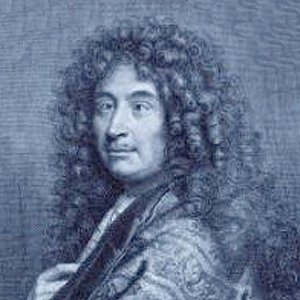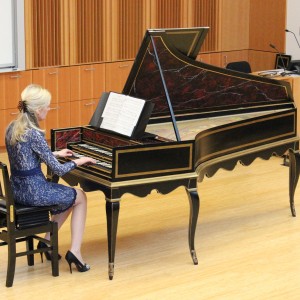An enthusiastic group gathered at Reed College in Portland on February 7th to learn about the harpsichord music of Jean Henry D’Anglebert. Reed’s new Performing Arts Building was both lovely to see, with its abundant light and open space, and it provided a room perfect for our requirements.
Event Publicity Printed Program
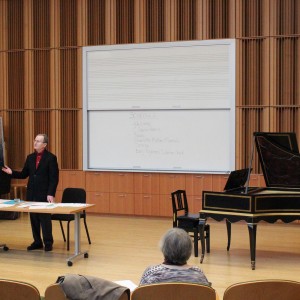 C. David Harris kept us enthralled for ninety minutes, first with the latest information about D’Anglebert’s life. We learned, for example, that D’Anglebert’s family name is Henry (D’Anglebert is a sobriquet used by the family), therefore the names “Jean” and “Henry” should not be joined by a hyphen as one often sees. A 1629 baptismal record for D’Anglebert was uncovered only in 1997. helping to fix this date of birth. Amazingly, when D’Anglebert married in Paris in 1659, the couple received a dowry valued at $100,000.
C. David Harris kept us enthralled for ninety minutes, first with the latest information about D’Anglebert’s life. We learned, for example, that D’Anglebert’s family name is Henry (D’Anglebert is a sobriquet used by the family), therefore the names “Jean” and “Henry” should not be joined by a hyphen as one often sees. A 1629 baptismal record for D’Anglebert was uncovered only in 1997. helping to fix this date of birth. Amazingly, when D’Anglebert married in Paris in 1659, the couple received a dowry valued at $100,000.
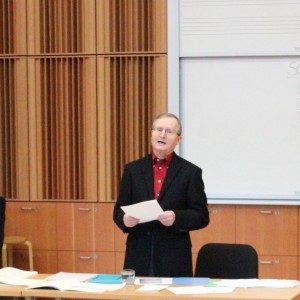 Professor Harris then toured highlights of his own work on the scholarly edition of D’Anglebert’s music published by The Broude Trust in 2009, giving us a glimpse of his behind-the-scenes work as editor. This new edition includes pieces from two sources that were not previously accessible, including a manuscript held privately in Britain by Guy Oldham. One of the three pieces from the Oldham manuscript is in a notation similar to lute notation, with note names on the staff, right-hand rhythms indicated above the staff, and left-hand rhythms indicated by position. Professor Harris’s analysis of the hand writing indicates that the pieces are written in D’Anglebert’s own hand. The new edition clearly indicates editorial choices and corrects errors found in previous editions. An important correction is the inclusion of a new ornament in which the last note of a trill is held, the retrograde of the tremblement appuyé in which the first note of a trill is held. Volume I of the edition includes all known pieces by D’Anglebert; Volume II includes alternative versions of the pieces as well as three essays, including an essay on performance practice in D’Anglebert. Several copies of the new edition were available for us to view, as well as a facsimile example of the lute-like notation used in the Oldham manuscript.
Professor Harris then toured highlights of his own work on the scholarly edition of D’Anglebert’s music published by The Broude Trust in 2009, giving us a glimpse of his behind-the-scenes work as editor. This new edition includes pieces from two sources that were not previously accessible, including a manuscript held privately in Britain by Guy Oldham. One of the three pieces from the Oldham manuscript is in a notation similar to lute notation, with note names on the staff, right-hand rhythms indicated above the staff, and left-hand rhythms indicated by position. Professor Harris’s analysis of the hand writing indicates that the pieces are written in D’Anglebert’s own hand. The new edition clearly indicates editorial choices and corrects errors found in previous editions. An important correction is the inclusion of a new ornament in which the last note of a trill is held, the retrograde of the tremblement appuyé in which the first note of a trill is held. Volume I of the edition includes all known pieces by D’Anglebert; Volume II includes alternative versions of the pieces as well as three essays, including an essay on performance practice in D’Anglebert. Several copies of the new edition were available for us to view, as well as a facsimile example of the lute-like notation used in the Oldham manuscript.
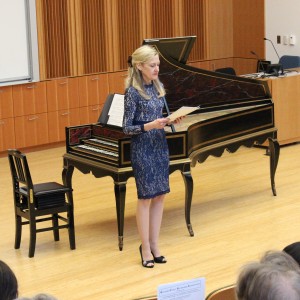 After a break with refreshments, Charlotte Mattax Moersch also kept us enthralled with a generous program of twenty-nine D’Anglebert pieces. She played on Reed’s Franco-Flemish double harpsichord built in 1974 by Ken Bakeman, restored by Byron Will in 2002, and retrofitted in 2014 by Paul Irvin.
After a break with refreshments, Charlotte Mattax Moersch also kept us enthralled with a generous program of twenty-nine D’Anglebert pieces. She played on Reed’s Franco-Flemish double harpsichord built in 1974 by Ken Bakeman, restored by Byron Will in 2002, and retrofitted in 2014 by Paul Irvin.
Before playing, Professor Mattax drew our attention to the various aspects of performance practice which D’Anglebert’s music requires: improvisatory style for the preludes, accented style for the dances, arpeggiation of chords, inégalité, rendering of ornaments, handling of harmonies, rhythmic pulse combined with fluidity, and sensitivity of touch. Her beautifully fluent and emotionally sensitive playing fully embodied Le son doré (the golden tone) which Kenneth Gilbert has said should be produced in playing D’Anglebert. Professor Mattax recorded D’Anglebert’s Pièces de clavecin for Centaur in 2014, and the recording will be released in 2015.
The program closed with a tour of the other instruments in the Early Keyboard Collection at Reed College (including a clavichord, a virginal, an Italian harpsichord, and a portative organ), a rich resource for early keyboard enthusiasts in the Northwest.
